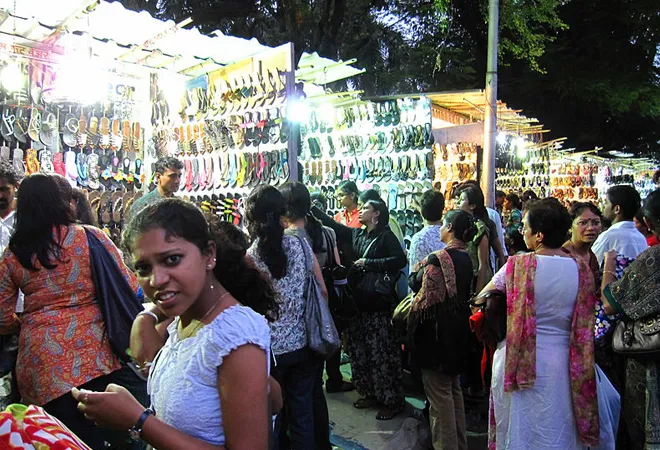-
CENTRES
Progammes & Centres
Location

The significance of gender has long been recognised from the perspective of gender justice. However, providing equality of opportunity is also a matter of national economic health. This has once again been confirmed by a recent study done by the Mckinsey Global Institute. The study has quantified the economic gains that would accrue to India if the goal of gender parity were achieved. This would lead to an annual addition of USD 770 billion by 2025, a GDP gain of 18 percent. But this would require the country to raise women’s participation in the labour force by 10 percentage points. Today, women account for a mere 24 percent of the labour force.
While India has been essaying multiple initiatives for empowering women, leading to the fastest progress in the Asia-Pacific region in recent years, much of it has been due to the country’s low base. If the indicators of gender parity score (GPS) are taken into account, India has deficits that are larger than several Asian countries. India, therefore, needs to cover huge ground to achieve gender parity in employment. These comprise elements of economic opportunity, legal protection and physical security. If we bear in mind that women who are already part of the economy are overwhelmingly engaged in the informal sector in less remunerative jobs, appropriate skilling would emerge as an area that deserves prioritised attention.
Since the national economy is getting more and more based in cities, the effort at creating employment for women will perforce have to be city-centric.
However, whereas national and state governments frame national and state policies and provide budgetary support to propel gender efforts, city-based policies are destined to play an equally significant part. Without such city-based support, national and state efforts may be stymied. Some of the city-centric services have a spatial dimension, which are vital to achieve gender parity.
Among the diverse groups of stakeholders that live in cities with sets of wide-ranging necessities that could differ from one another, the needs of women, constituting almost half the city, becomes a clear priority. City administrations must realise that there is no imaginary ‘average citizen’ in a city and they cannot draw comfort from the belief that the same set of services will cater to the needs of all of them. Cities must segment populations and in part customise services to satisfy their unique requirements. This is a difficult task. However, it is only then that a city can be branded as inclusive.
In regard to women, cities first need to spell out their objectives in keeping with the national goals. These objectives are likely to be the following:
Following the objectives, cities should make a proper analysis of the factors that impede employment of women in their cities. It would emerge that many of these deficits are a consequence of the lack of provision of space and, hence, to flaws in the cities’ Development Plan. The Development Plans of cities, therefore, need serious gendering.
Among the reasons that make the participation of women onerous in cities is lack of temporary housing for single women, limited care facilities for children of married women and single mothers, lack of market/vending space and training facilities for informal sector women workers, lack of public conveniences and adequate transport.
If the overall objective in the country is to make women a much larger proportion of the work force, then the cities will have to bridge gaps that exist in the cited services.
City plans should provide space for multi-purpose hostels, spread over the city in different wards. This should comprise single and double rooms, dormitories, studio apartments and should be available on affordable rent. It should also have a guest house for women who travel to the city for work. The space should ideally include conference rooms and multi-purpose halls that can be used for skill provision, lectures and sharing. Preferably, they ought to be located in areas where commercial, office establishments and institutions of higher learning exist. Additionally, these multi-purpose hostels should be equipped with child care facilities with common work area for women and reading room facilities.
City plans should have spatial provision for ‘adhar kendras’ or support centres performing several functions. They should be designed to stock products made by SHG (Self Help Groups) women. The centres could also provide people-skilled workers for services. In addition, these centres should have multi-purpose halls to be used for entrepreneurial training to SHGs. These should be located in areas that have sufficient footfall, preferably around markets and railway stations and on the main roads to ensure visibility. City plans should take cognisance of the Street Vendors Act and facilitate the creation of hawking zones in the city with areas demarcated for women. Spaces should also be created within markets for hawking by women that could serve as outlets for goods produced by the SHGs.
Government of India has been emphasising imparting training for skills. Women are especially suited to provide some of the services required in a city. However, there is no reason to restrict women to traditional job areas. Women, if properly skilled, have the innate ability to transcend conventional obstacles and prove themselves in uncharted employment and entrepreneurial areas. Cities should therefore provide space for women ‘skill centres’ with tailor-made courses within the adhar kendras.
Women require specialised public convenience blocks and these should be available across the city. These blocks would have general public toilets and some exclusive toilet blocks for women, designed differently to cater for gender.
This would comprise toilet blocks with scientific disposal mechanisms for sanitary pads and drinking water facility at the ground level with another floor built to provide changing room and resting space for naka and domestic workers, as well as drinking water facilities.
Such gendering of the development plans of cities still leaves a significant question unanswered. Who builds and runs these facilities? Given the paucity of resources with ULBs (Urban Local Bodies) as well as the lack of management expertise within ULBs for running these specialised social services, it would be advisable that the private/social/NGO sectors are invited to take up the provision and maintenance of these services. However, the rules of the game have to be set by the ULB so that there is a balance established in terms of broad basing the services and that they are not made purely commercial ventures. The rules, therefore, need to be drafted carefully, allowing for some profit enabling proper upkeep of the premises and the hiring of quality professionals. At the same time they should allow women from all economic strata to find a place in these facilities. This would require differential rates to be charged from women depending on their levels of income.
Many other steps for ‘gender mainstreaming’ in cities could be thought of. The fundamental point, however, is that cities must wholeheartedly join in the national effort towards the achievement of gender equality.
The views expressed above belong to the author(s). ORF research and analyses now available on Telegram! Click here to access our curated content — blogs, longforms and interviews.

Dr. Ramanath Jha is Distinguished Fellow at Observer Research Foundation, Mumbai. He works on urbanisation — urban sustainability, urban governance and urban planning. Dr. Jha belongs ...
Read More +